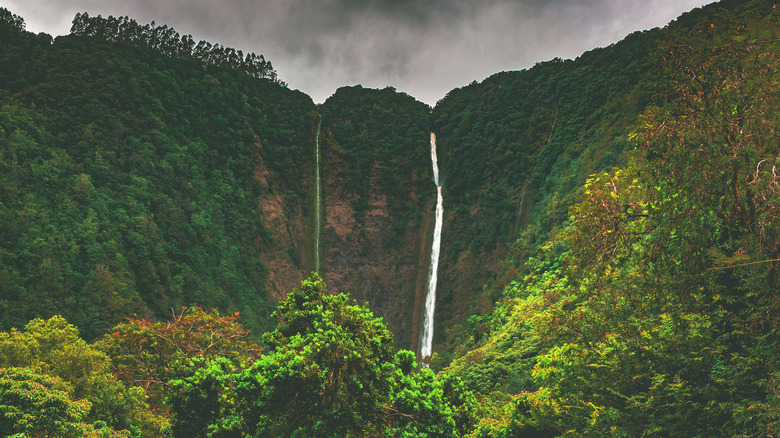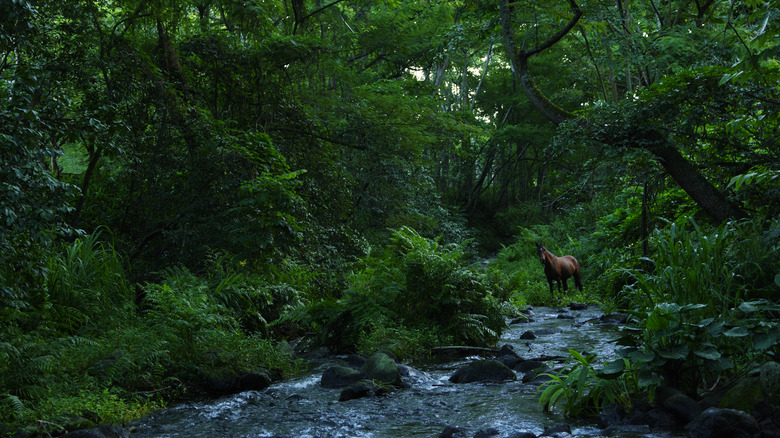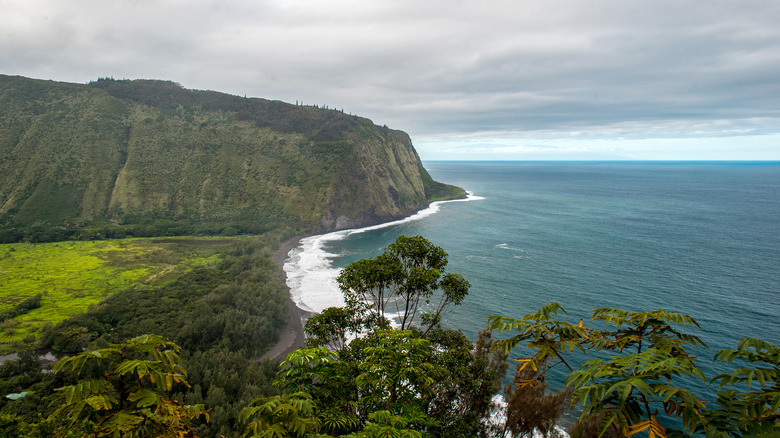How To Experience One Of Hawaii's Most Powerful, Secluded Waterfalls
While many know the state of Hawaii as the ultimate swimming and snorkeling destination, there's so much more to experience across its eight volcanic islands for those willing to explore off the beaten path. Hawaii's Big Island, the largest in the chain, offers outdoor enthusiasts plenty of opportunities to connect with nature, boasting numerous natural sites and areas to explore inland, from towering canyons to vast valleys.
One such natural wonder is the immense Hi'ilawe Waterfall. This Hawaiian island hidden gem offers visitors a chance to escape to a secluded jungle haven. Hi'ilawe is the tallest waterfall in Hawaii, with a height of 1,450 feet and a sheer vertical drop of 1,102 feet. Once considered the most powerful waterfall across Hawaii's eight main islands, its flow has been reduced since the construction of a dam in 1989 — what was a momentous flow of water is now more akin to a steady stream. Despite this, the falls remain a stunning spectacle, and their incredible towering height is sure to leave onlookers in awe.
Formed from the now dormant Mauna Kea shield volcano, the falls' rugged surroundings and lush foliage make it an incredibly scenic and secluded spot. It's important to note that as of the time of writing, the only way to visit Hi'ilawe Waterfall if you are not a Hawaiian resident is with an organized tour. Typically, more tourists tend to visit Hawaii during the winter months. This period is great to catch Hi'ilawe Falls in all its glory, as November to March is the rainy season. This timing will make for a distinctive experience that makes a trip to Hawaii in the winter so special.
The unique history of Hi'ilawe Falls
Hi'ilawe Falls sits next to its sister waterfall, Hakalaoa Falls, which is often dry. Both are located in the sacred Waipi'o Valley, nestled in the Kohala Mountains in the northeast of Hawaii's Big Island. The valley is incredibly picturesque, with lush vegetation, towering cliffs, and a black sand beach — an echo of the island's volcanic origins. Edged by the Pacific Ocean, Waipi'o Valley's indigenous roots predate the arrival of Captain Cook in 1778, and it is home to several temples, including the sacred Paka'alana, as well as some notable burial sites. This sacred space is also nicknamed "The Valley of the Kings," having been the home of Hawaiian royalty, such as King Kamehameha I.
Historically, Waipi'o's fertile land and abundant water supply supported a population of several thousand indigenous Hawaiians. Today, less than 100 people live in the valley, many of whom are taro farmers. This dramatic change is mainly due to the catastrophic effects caused by a tsunami in 1946. More wild horses than people roam the land today and can be spotted by lucky visitors. As a birdwatcher's paradise, the valley is also home to a variety of bird species, including the native Pueo owl, black-crowned night heron, and Koloa Maoli duck.
Plan your visit to Hi'ilawe Falls
Witnessing Hi'ilawe Falls in all its glory is tricky to organize, as it's a rare experience reserved for persistent and adventurous travelers. Due to deteriorating road conditions, access to the valley has been restricted since 2022. Entry permission to Hi'ilawe Falls and Waipi'o Valley is only granted to certain groups or individuals, such as Hawaii residents and licensed tour operators. Even before these restrictions were put in place, visiting the falls on your own required navigating private property and dangerously steep terrain, accessible only by 4x4 vehicles.
As of 2024, there are two of main ways you can visit Hi'ilawe Falls. Waipi'o Valley Shuttle offers licensed tours of the valley. One TripAdvisor reviewer said, "Our tour driver was incredibly friendly, knowledgeable (he had lived fulltime in the valley for a few years), and talked to us throughout the trip about what we were seeing. This is an incredible experience and one that we would highly recommend!" Since there are very few amenities in Waipi'o Valley, visitors should bring their own snacks and water.
You can also witness Hi'ilawe Falls from the air. Blue Hawaiian Helicopters offers a Hilo Waterfall Experience Tour, which takes you to a series of breathtaking remote locations, including Waipi'o Valley and Hi'ilawe Falls. While Hawaii offers many natural hidden gems, observing this valley's beauty and expansiveness from an aerial perspective provides a truly unforgettable travel experience.


